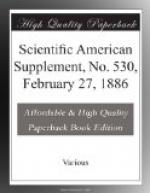“On the afternoon of Saturday, the 14th of July, 1860, between the hours of 2 and 2:30 P.M., the station of Dhurmsala was startled by a terrific bursting noise, which was supposed at first to proceed from a succession of loud blastings or from the explosion of a mine in the upper part of the station; others, imagining it to be an earthquake or very large landslip, rushed from their houses in the firm belief that they must fall upon them. It soon became apparent that this was not the case. The first report, which was far louder in its discharge than any volley of artillery, was quickly followed by another and another, to the number of fourteen or sixteen. Most of the latter reports grew gradually less and less loud. These were probably but the reverberations of the former, not among the hills, but among the clouds, just as is the case with thunder. It was difficult to say which were the reports and which the echoes. There could certainly not have been fewer than four or five actual reports. During the time that the sound lasted the ground trembled and shook convulsively. From the different accounts of three eyewitnesses there appears to have been observed a flame of fire, described as about 2 ft. in depth and 9 ft. in length, darting in an oblique direction above the station after the first explosion had taken place. The stones as they fell buried themselves from 1 ft. to 11/2 ft. in the ground, sending up a cloud of dust in all directions. Most providentially, no loss of life or property has occurred. Some coolies, passing by where one fell, ran to the spot to pick up the pieces; before they had held them in their hands half a minute they had to drop them, owing to the intensity of the cold, which benumbed their fingers. This, considering the fact that they were apparently but a moment before in a state of ignition, is very remarkable. Each stone that fell bore unmistakable marks of partial fusion.”
Several meteors were seen at Dhurmsala on the evening of the same day.
Dr. C.T. Jackson analyzed a portion of one meteorite weighing 41/2 oz.; the piece was 21/2 in. long, 11/4 in. wide, and 1 in. in average thickness. In the course of his report he stated: “Its specific gravity is 3.456 at 68 deg. Fahr., barom. 29.9. Its structure is imperfectly granular, but not crystallized, and there are small black specks of the size of a pin’s head, and smaller, of malleable meteoric iron, which are readily removed from the crushed stone by the magnet. The color of the mass is ash gray. A portion of the surface is black and is scarified by fusion. Its hardness is not superior to that of olivine or massive chrysolite. Chemical analysis shows that its composition is that of a ferruginous olivine. One gramme of the stone, crushed in an agate mortar, and acted on by a magnet, yielded 0.43 gramme of meteoric iron, which was malleable. After the removal of this a qualitative analysis was made of the residual powder. Another gramme was




